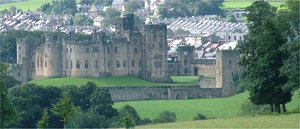Alnwick Castle
|
|

Alnwick Castle is a castle and stately home in Alnwick, Northumberland, England.
Yves de Vescy , Baron of Alnwick, erected the first parts of the castle in 1096. It was built to defend England's northern border against the Scottish invasions and border reivers and it has been owned by by the Percy family, the Earls and later Dukes of Northumberland since 1309. The first Percy lord of Alnwick restored the castle and the Abbot's Tower, the Middle Gateway and the Constable's Tower survive from this period.
The 6th Earl of Northumberland carried out renovations in the 16th century. In the second half of the 18th century Robert Adam carried out many alterations. The interiors were largely in a Strawberry Hill gothic style which was not at all typical of his work, which was usually neoclassical. According to the official website a large amount of Adam's work survives, but little or none of it remains in the principal rooms shown to the public, which were redecorated in an opulent Italianate style in the Victorian era.
An aerial view of the castle is shown on the home page of the official site [1] (http://www.alnwickcastle.com/). The castle consists of two main rings of buildings. The inner ring is set around a small courtyard and contains the principal rooms. This structure is at the centre of a large bailey. As the central block was not large enough to contain all the accommodations required in later centuries, a large range of buildings was constructed along the south wall of the bailey. These two main areas of accommodation are connected by a link building. There are towers at regular intervals along the walls of the outer bailey. About a sixth of the bailey wall has been reduced almost to ground level on the bailey side to open up views into the park. Stable and service yards adjoin the castle outside the bailey; these would not have existed when the castle still had a military function.
Alnwick castle has two parks. Immediately to the north of the castle is a relatively small park straddling the River Aln which was landscaped by Lancelot Brown ("Capability Brown") and Thomas Call in the 18th century; it is known as locally as The Pastures. Nearby is the much larger Hulne Park, which contains the remains of Hulne Priory.
The castle is in good repair and used for many purposes. It provides a home for the present Duke and family and offices for Northumberland Estates, which manages the Duke's extensive farming and property holdings.
Since the Second World War, parts of the castle have been used by various educational establishments: Firstly, by the Newcastle Church High School for Girls then, from 1945 to 1975, as a teacher training college and, since 1981, by St. Cloud State University as a branch campus forming part of their International Study Programme.
Special exhibitions are housed in three of the castle's perimeter towers. The Postern Tower, as well as featuring an exhibition on the Dukes of Northumberland and their interest in archaeology, includes frescoes from Pompeii, relics from Ancient Egypt and Romano-British objects. Constable's Tower houses military displays like the Percy Tenantry Volunteers exhibition, local, volunteer soldiers raised to repel Napoleon's planned invasion in the period 1798-1814. The Abbot's Tower houses the The Regimental Museum of the Royal Northumberland Fusiliers.
The castle was used as a location in the films Harry Potter and the Philosopher's Stone and The Chamber of Secrets. It has previously been a location used in Blackadder I, Robin Hood Prince of Thieves and many others listed in the Location section of the Alnwick Castle website.
The castle is open to the public throughout the summer.
Alnwick Garden
Adjacent to the castle, the present Duchess of Northumberland, Jane, has established the Alnwick Garden, a formal garden set around a cascading fountain. It is the most ambitious new garden created in the United Kingdom since the Second World War, with a reported development cost for the whole of £42 million pounds (press release of 7 August 2003). The garden belongs to a charitable trust which is separate from the Northumberland Estates, but the Duke of Noerthumberland donated the 42 acre (170,000 m²) site and £9 million. By 2004 it was the third most visited paid entry garden in the UK after (Kew Gardens and Wisley), with over half a million visitors. As of 2005 several elements of the garden remain to be developed.
The first phase of development, opened in October 2001, involved the creation of the fountain and initial planting of the gardens. In 2004 a large 'tree house' complex, including a cafe, was opened. In February 2005, a poison garden, growing plants such as cannabis and opium poppy, was added.
The purpose of the garden is to augment the facilities available on the Alnwick Castle site for tourists and educational visitors.
See also
- Syon House - the west London residence of the Dukes of Northumberland.
- Northumberland House - the former central London residence of the Dukes of Northumberland.
- Petworth House - belonged to the Earls of Northumberland until the 17th century
External links
- Alnwick Castle (http://www.alnwickcastle.com/)
- Alnwick Garden (http://www.alnwickgarden.com/)
- The Northumberland Fusiliers Museum (http://www.northumberlandfusiliers.org.uk/)
- Overhead photo from multimap.com (http://www.multimap.com/map/photo.cgi?client=public&X=419000&Y=613500&width=700&height=410&gride=418693.950516278&gridn=613236.259228672&srec=0&coordsys=gb&db=freegaz&pc=&zm=0&scale=10000&multimap.x=242&multimap.y=194) - dates from around 1999. The largely derelict site of Alnwick garden is at the bottom right.
